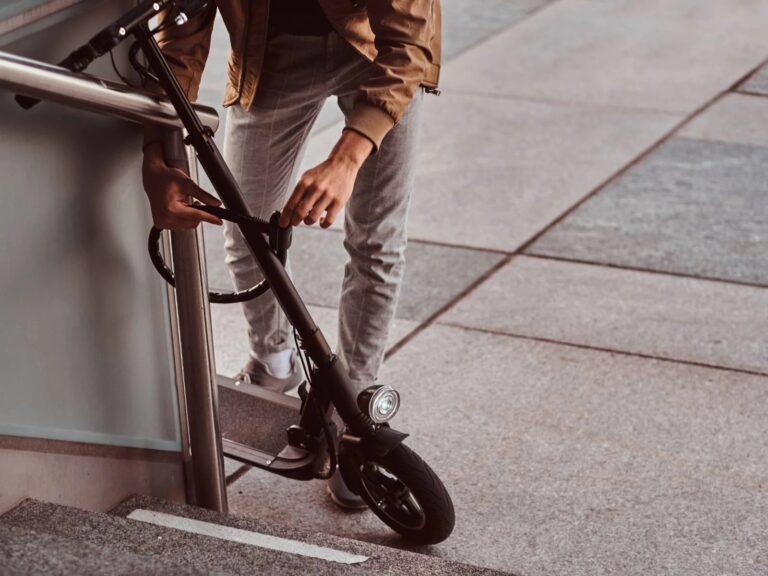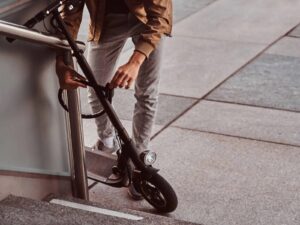Riding something on two wheels in the rain is always fun, and bicycles and regular scooters are great fun when slamming through puddles without a care. But can the same be said for electric scooters? Your immediate answer might be: “Of course not, electrics and water don’t mix”. But that’s not always true.

Source: Moose
Many factors go into determining if an electric scooter can be ridden in the rain and how its electrical components are protected from water damage. These can include build quality and a “protection rating”, which determines just how waterproof the exterior of an electric scooter is.
What to consider when choosing a waterproof electric scooter?
Generally, electric scooters can be considered either water-resistant or waterproof. This refers to an Ingress Protection, or IP rating, which denotes the enclosure of a surface or mechanical object and its permeability. IP ratings are established on everything from cars to lawnmowers and almost anything that’s ‘enclosed’ that may come into regular contact with water.
Another important factor to consider when choosing a scooter for riding outside is the amount of sealing on the scooter’s frame and body. Typically, electric scooter bodies are rated from IPx3 through to IP67. Most electric scooters offer some form of water resistance, even though they may only be able to handle light rain or mist and fog, but no electric scooter is truly waterproof.
However, many critical areas of your scooter must be sealed to prevent water damage and corrosion. These include the battery housing, all connection points between your electric scooter battery hardware and any electrical parts of your scooter, such as a digital display. When choosing a waterproof or water-resistant electric scooter, consider how well-sealed its components appear.
Tips for riding an electric scooter in the rain
Regardless of any IP ratings, no scooter is 100% waterproof. Therefore, you should still take care when riding in wet conditions, not only for your safety while riding on the road (as deep water can affect your traction if you have pneumatic tyres) but also for the health of your electric scooter and its electrical components such as the battery pack.
Do not ride your scooter in a torrential downpour, and do not ride through any deep puddles to avoid water splashing onto any insufficiently protected components.
If you must ride in the rain on your commuting scooter, slow down if the conditions are too wet to operate safely. Wet ground beneath your wheels can cause you to lose traction and stopping distance when braking, even if your scooter is equipped with regenerative braking technology, making its brakes more efficient.
Suppose you are riding your scooter in wet conditions off the pavement (perhaps you have an off-roading electric scooter with large pneumatic tires). In that case, you must take extra precautions as not all electric scooters are rated for mud.
Once you finish your ride, you must wipe down your scooter to free it from mud, dust or other debris. All electric scooters have some form of dust protection, but excessive wet mud buildup can cause problems with your electric scooter’s electrical components. Carefully wipe off your scooter after each ride to keep it clean and dry.
Different types of electric scooter water resistance
Below, we’ll break down the different types of water resistance most electric scooters offer. Electric scooter IP(Ingress Protection) ratings denote how much water an electric scooter can be exposed to before its electrical components become compromised or non-functional. Riding an electric scooter in wet conditions for which it is not rated is highly inadvisable, as you may cause fatal damage to the scooter’s controller or electric scooter battery, wrecking your scooter.

Source: Gotrax
IP65
An IP rating of 65 means your scooter can withstand light rain, dust, debris and water splashing from any angle. If you’re looking for a commuting scooter that you’ll use year-round, an IP rating of 65 should be considered the bare minimum for your next electric scooter.
It should be noted that riding an e-scooter in the rain for any extended period, regardless of the IP rating, isn’t advised.
IP66
While electric scooters with an IP rating of 66 can incur splashes of water from any angle, the next step up in water resistance are those with ratings of IP67. IP66 allows the scooter to take sustained, powerful water jets from any direction. This means that you could wash your IP66 rated electric scooter with a hose if you wanted to, although you’re likely still better off using a cloth or vehicle wipes to clean it.
IP67
Electric scooters with an IP rating of 67 can be submerged in one-metre deep water for thirty minutes, although this should be avoided if possible. Its undercarriage is often waterproof, and any electrical connections are covered and sealed during construction. While IP67 may seem extreme for the daily commuter, it can be a good option for those who like to take their pneumatic-tyred electric scooters off-road.
IP68
Finally, we have an IP rating of 68, among the highest on the IP ratings table for electric scooters. This number means the scooter can be submerged in more than a meter of water for over thirty minutes. Electric scooters with this level of water resistance are generally among the most expensive. They would be well-suited for individuals living in locations with lots of yearly rainfall or those participating heavily in off-road electric scooter activities.
Can I waterproof my own electric scooter?
While it is certainly possible to DIY your electric scooter’s water protection, it’s advised that you bring it to a professional. However, yes, you can DIY waterproofing your electric scooter. Some may wish to use duct tape to waterproof their electric scooter. This is ill-advised and will likely fail after some time, causing potentially fatal damage to your scooter’s electrical components.

Source: Scooter.guide
Another option when your electric scooter becomes wet is to cover it completely with a waterproof cover, particularly if you’re leaving your e-scooter outside.
You can apply silicone-based waterproofing products to various connectors if you want to waterproof your electric scooter components. You must not cover any holes that allow the scooter to function properly. Silicone-based waterproofing products take up to 12 hours to dry; give your scooter 12 hours of drying time after application.
If you wish to waterproof your scooter motors to prevent rusting, apply a layer of grease to the motor wheel axles. Your scooter may have a single motor (front or rear wheel motors) or a dual motor (front and back wheel motors). Applying a layer of grease to the axle will help improve its water resistance.
Pros and cons of DIY waterproofing?
If you’re not sold either way on DIY waterproofing or bringing your electric scooter to a professional, here are some pros and cons.
Pros:
- Money savings: It will cost less to waterproof your electric scooter yourself than a professional shop or your manufacturer may charge you.
- More customisation options: When it comes to DIY waterproofing, you have control over what gets the waterproof treatment. This includes what materials you’ll use and how liberal you’ll be with applying the waterproofing agents in a professional mechanic’s or the manufacturer’s shop.
Cons:
- Risk of damaging your scooter: There is a significant risk that you may do more harm than good by DIY’ing this task. You could accidentally over-apply silicone near an electrical component, causing damage to the component.
Or you could not apply enough sealant. You could choose the wrong type of sealant for your scooter model or cause damage to the existing IP rating by unwittingly applying a corrosive agent. DIY’ing the waterproofing process of your scooter increases the risk that you’ll unknowingly damage a key component, potentially breaking your scooter.
- Warranty issues: Waterproofing your electric scooter by yourself could create warranty issues with the manufacturer if there is a defect within the warranty period of your scooter. Be careful when doing things to your scooter that may affect your warranty.
- Time-consuming: Another reason not to DIY the waterproofing of your electric scooter is that it is a time-consuming process. Using silicone-based solutions will take at least 12 hours to dry, as mentioned above, and other waterproofing methods may take longer by the time you take everything apart, apply the waterproofing sealant and then put it all back together again.
This doesn’t account for mistakes that may need rectifying during the process or if you notice a mistake afterwards and must redo everything.
Summing up
Most modern electric scooters offer some form of waterproofing and protection from errant splashes. None are completely waterproof. If waterproofing of an electric scooter is important to you, be sure to choose a scooter with an IP rating of 66 or above, as IP65-rated scooters are only suitable for light precipitation.
Brands like Ninebot Maxs, Kaabo Wolf King, and Apollo Phantom have made their mark in the market with their impressive electric scooters’ battery life and water-resistant features. However, it’s crucial to understand that water resistance does not mean they can withstand immersion in water or direct contact with high-pressure water jets.
For heavy riders, models like Wolf King GT Pro and EMOVE Roadrunner offer excellent ride quality and robust build. These scooter brands are also known for their maximum range and top speeds. To enhance your electric ride, consider investing in scooter accessories like quad lock phone holders or helmets.
Understanding what the IP ratings mean can be a frequently asked question. In simple terms, the water-resistance rating indicates the level of protection against water and debris protection. A model like the Kaabo Wolf Warrior, for instance, might be rated IP54, meaning it has some level of protection against dust and low-pressure water. Still, it is not designed to endure heavy rains or immersion in water.
Buying an electric scooter like the Wolf King GT, Apollo Pro, or even folding electric designs like the Unagi Model One requires careful consideration of these factors.
Always remember this top tip: no matter how water-resistant your scooter is, always avoid leaving your scooter outside in wet weather for prolonged periods. And remember to check the grip tape and electric scooter lights, especially if you’re riding in low visibility conditions.
Avoid DIY waterproofing if possible, but if you decide to do it yourself, have a professional check your work.





